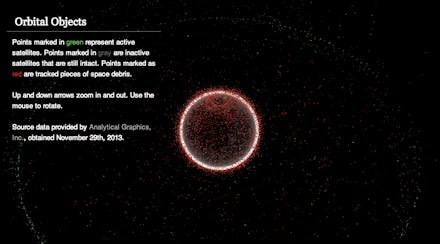Experience Just How Much Space Junk is Floating Around, in One Astounding Interactive

It's crowded up there: We all know that humans have created a lot of garbage on Earth, but did you know that the amount of junk we’ve created in space is equally extraordinary? These two interactives give you a feel for just how much. The first (above), made by Alex Rasmussen, compares the amount of active satellites (green) with inactive spacecraft (gray) and fragmented space debris (red). As you can see, there’s a lot of red dots.
Although it’s difficult to observe exactly how many there are, the European Space Agency (ESA) estimates that there are 29,000 pieces larger than 10 cm, 670,000 larger than 1 cm and more than 170 million larger than 1 mm. The debris has a total mass of more than 6,300 tonnes and can travel as fast as 35,000 miles per hour.
Image: Google Earth based interactive showing details about satellites and debris in orbit. Click here to open interactive media (Credit: satellitespy.net)
In over 50 years of space activity, 6,600 satellites have been launched with 3,600 remaining in orbit, and 1,000 of these are still active today. A second visualization, made by Dr. Bob Gough who has worked with the ESA, gives you the chance to find out just what these satellites are and where they came from.
Should we be worried about all this trash? Given the astounding amount of disused satellites and space debris floating up there and the speeds that they are all moving at, should we be worried about collisions?
The first thing to remember when looking at the interactive maps are that the scale of dots are exaggerated; in reality the debris is much further apart. Still,the space agencies are cautious, because space infrastructure is extremely valuable — the potential cost of losing 1,000 active satellites to a floating piece of junk is $130 billion.
Image: Increase of satellites and space debris in orbit (Credit: ESA)
About 100 to 150 tonnes of space junk re-enters Earth's atmosphere each year. The most recent significant occurrence was when a NASA satellite and a German satellite collided and landed in the Bay of Bengal in 2011. Last year, a piece of debris from a Chinese satellite hit an active Russian spacecraft. Astronauts can be affected too. In 2012, the International Space Station moved to a higher orbit to avoid colliding with debris from a Japanese satellite.
What’s the solution? While a Gravity-like scenario is unlikely, given the number of avoidance measures NASA is prepared for (the International Space Station is the “most heavily shielded spacecraft ever flown”), the velocity and increasing number of space debris is dangerous. Scientists worry about the Kessler syndrome: a scenario where there is so much debris that it would be impossible in launch anything without a high risk of fragmentation. This chain-reaction could mean that our access to space would be lost.
Space agencies are now looking to develop better tracking and clearance infrastructure after being complacent for many years. The proposed missions to clean up the debris involve many imaginative proposals (see below): One involves "chasing" satellites that have space harpoons which can secure debris and drag it down to burn in the Earth’s atmosphere; another involves "harvesters" which collect still functioning pieces and use them to build new satellites in orbit.
Whatever ends up being the most effective method, one things for sure: litter up in space is as costly to us as it is on the ground. To continue benefiting from our access to space, and all the communications, monitoring, and scientific advantages that come with it, we’ll need to learn how to keep it clean.
Image: Proposals for space debris clearing technology (Credit: ESA)